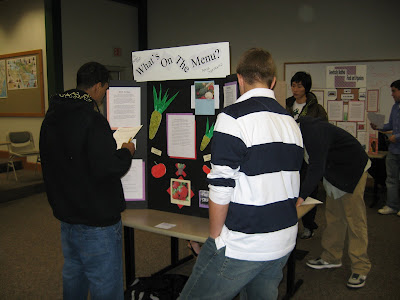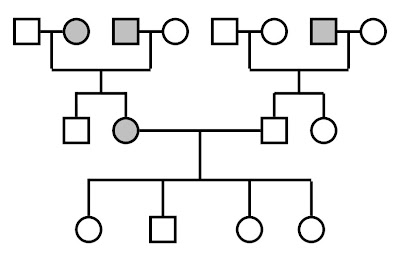From now on we will be working from here: www.globalproblemslocalsolutions.blogspot.com
So what are you waiting for? Click on the link to check it out!
From now on we will be working from here: www.globalproblemslocalsolutions.blogspot.com
 The boys in blue: Flash, Max and Leo with their poster on GMO's.
The boys in blue: Flash, Max and Leo with their poster on GMO's. Posters on GMO's & Stem Cells
Posters on GMO's & Stem Cells Jason critiques Pat & Mike's poster on GMO's
Jason critiques Pat & Mike's poster on GMO's Students critique each other's work.
Students critique each other's work.Today and tomorrow during long block students worked on their summary statements for their project. I will review the statements tonight and you will finalize them in the next class.
What is a summary statement?
This should be 7-10 sentences describing your issue, what are the key issues, what might the future look like for your issue. This must be an original statement. Below is a problem statement on domestic violence from: http://www.ojp.usdoj.gov/Kits/Family/probst.htm
4. Multimedia Resource List: A resource list is a way to organize your research.
Your list must include each of the following (1 point for each source).
EXAMPLE: Global Warming in NH: http://www.ucsusa.org/global_warming/science/global-warming-in-new-hampshire.html
You can look for videos at www.youtube.com , http://video.google.com/ , the school library catalogue (Athena) and through Gordon Nash Library (you know….the building across the street). Catalogue is online at: http://www.nhu-pac.library.state.nh.us/#focus . In the search box select “broad keyword.” To narrow your search, include the word “video.” For example you may search “Human Genome video.”
Sample Summary Table
| Title | Summary |
| Author | |
| Date Published | |
| Source | |
| Date Obtained |



 Assignment #2 is due IN CLASS on MONDAY.
Assignment #2 is due IN CLASS on MONDAY.Sample Summary Table
| Title | Summary |
| Author | |
| Date Published | |
| Source | |
| Date Obtained |
Genetic screening is the use of blood or chromosome tests to detect genetic disorders. Screening can be performed at different stages in life, from prenatal to adulthood. Tay-Sachs, PKU, and sickle-cell anemia are examples of genetic disorders that can sometimes be detected using genetic testing. Genetic screening can detect both afflicted individuals and carriers of a disease. Genetic screening is a controversial topic, due in part to the varied uses of this technique and their ethical, social, and legal implications. Genetic screening of fetuses allows the detection of diseases such as Tay-Sachs and PKU. Some advocates of screening suggest that this will allow undesirable fetuses to be aborted, saving a lot of money and heartache. Many people oppose screening for this purpose because it prevents individuals, who would normally be given the chance to live and find happiness, from being born. Some diseases, such as PKU, can be controlled or prevented if they are detected early. Screening allows early detection of these diseases in newborns and can possibly improve the quality of life of some individuals. Adults can be screened premaritally to see what probability they have of producing a child with a particular disease or undesirable trait. They can work with a genetic counselor to determine what steps to take in child-bearing. Some states are offering voluntary genetic screening while others have made it mandatory for certain diseases. There are many factors to consider when deciding whether or not screening should occur, when in the lifecycle it should take place, for what purpose it should be done, and who should be screened. For instance, genetic screening is not foolproof. Some tests can only show the probability that a person is a carrier. Does this weakness affect your thinking on genetic screening? How?
January Notebook Check (each question is 2 points)
Directions: For each of the words below, give an example or description, you may also draw a picture.



 If you're struggling with how meiosis happens, watch this animation.
If you're struggling with how meiosis happens, watch this animation. meiosis
meiosis Homework: Read section 9.5 in your books and make flashcards for the key concepts on page 192. If you haven't finished the review word search from class, do that as well.
Homework: Read section 9.5 in your books and make flashcards for the key concepts on page 192. If you haven't finished the review word search from class, do that as well.In my opinion class got off to a slow start, however once we learned more about each other the class really started to move. I was surprised (and pleased) to see how many of you wrote that “writing a lab report” was the most valuable skill you learned. Your lab reports certainly have come a long way. I will try to have earlier extra help for the day students to come to; if you are a day student, please arrange a time with me that is convenient. Boarding students, extra help is available on Thursday nights in Moore House.
 These words or phrases came up repeatedly. The number is parenthesis is the number of times the word was mentioned. The text in bold is the question that was asked on the survey.
These words or phrases came up repeatedly. The number is parenthesis is the number of times the word was mentioned. The text in bold is the question that was asked on the survey.
What is my class like? Fun (8), Learning a lot (5), I like it (3)
What is the most interesting thing you’ve learned? Cancer (10), Mitosis (4)
What has been your favorite assignment? Cell cycle project (3), Egg lab (3)
How often do you visit the blog? Everyday (1) A few times a week (4) a couple of times (5 ) every week (3) rarely/never (4)
What is the most valuable skill you learned? How to write a lab report (8), Use a microscope (3), Take notes (3) Do a project by myself (2) Make a blog entry (1)
What are three things you like about my teaching style? Never boring (4), Hands On (4),
visual (3), not all board w ork (3), funny (3)
ork (3), funny (3)
What are three things you think I need to work on? Nothing (8), Stay more on topic (3), less homework (3) More outside activities (2)
If Mr. Menke asked you what this class was like, what would you tell him?
Enjoy class, so interesting, good, interactive, hands on, hard in a good way, active, it’s all right it’s a little boring, ms. Saxe knows what she’s talking about, good sense of humor, mixture of projects, homework and interactive labs, visual, a good learning environment.
What is the most interesting thing you have learned so far? Why was it interesting?
Everything, biology is my favorite class * when we watched the movie on the ocean and learned how big the whale and the sting ray are[1] * the cell cycle and cancer, it was interesting to see how cancer can spread, mitosis because you get to see what is happening inside your cells * cancer * how many types of cancer there are * mitosis because it goes on inside me * too much info to decide * cancer and its causes * the cell cycle, mitosis and cancer * speech for project because I never saw that in China * mitosis because it is happening to us all the time * cancer because you learned about a major cause of death and disease * different types of cancer, what types vary between males and females * how cancer spreads and forms * learning about cancer has made me more aware * the labs because I am learning how to write a lab report properly.
What has been your favorite assignment?
I don’t have a favorite, I like them all * the eggsperiment * the egg lab * discussion on Sam and his cancer * making the board game * cell cycle and mitosis project * labs & projects * egg lab * the game with the little white boards * making posters * mitosis flash cards * whenever we work with partners * cell cycle project * cell cycle project * cell cycle powerpoint * pond walk * food lab.
Least favorite assignment?
I haven’t disliked anything * homework assignments you need the blog to get to * our first lab report * trying to figure out the stages of mitosis under the microscope * the carbohydrate project * eggsperiment because we broke the egg * the enzyme project * metric system * lab reports because they are so long and draining * lab reports are too hard and complicated * assignments because I need a lot of time * lab write ups * the enzyme project because it was hard to find info and it was long * the 54321 because I didn’t want to write a lot[2] * rip-o-meter lab because I didn’t do very well * the enzyme project was boring * I don’t have a least favorite.
What are three things you like about my teaching style?
Happy * active * fun* understanding* laid back (but we still learn)* helpful* descriptive* goes slow with the material * gets students involved * we review a lot * you have everything on the blog * you’re nice* you’re expressions* not slow * keep us working hard * explain everything carefully* not uptight * relaxed * not obnoxious* not monotone * try to make things fun* interact with us as a person* rather than a teacher* you know what you are talking about* hard* always prepared* very reasonable* no matter what* I always learn something* verbal* worksheets/fun case studies* objective of the day* I like your teaching style.
What are three things you think I need to work on as a teacher?
More case studies * go further in depth * have early extra help[3] * give us one class off a week * N/A (8) *excepting late work * shorter lab reports * more hands on activities * less notes
[1] The students were having a hard time understanding how big 20 meters is, so I laid out 10 meter sticks and told them to imagine a whale twice as big.
[2] I find this funny, because I only had students write one 54321 the entire year, where last year they had to write one every week.
[3] I would like to do this, although it’s tough finding a time. Maybe on Monday’s in the winter after snowsports jobs?